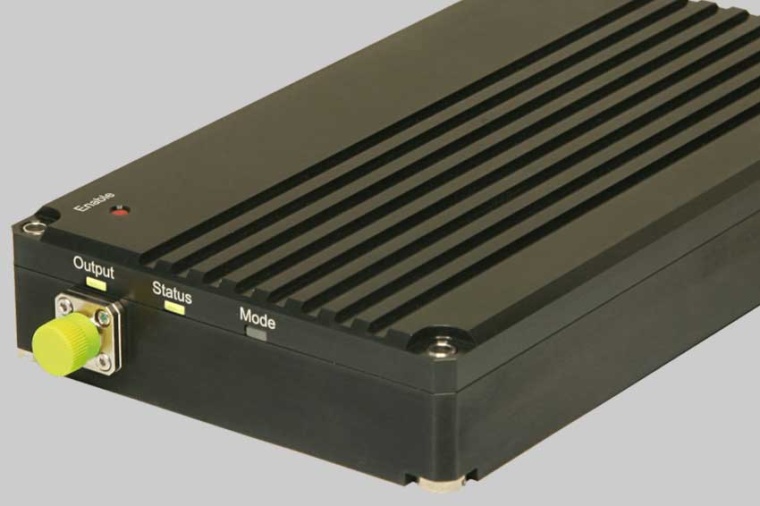Ramping up net speeds to 40 Tb/s
Optical combs and InP PICs get the most out of optical fiber networks.
An industrial research collaboration between scientists and engineers from Ireland, the Netherlands, and Germany have found a way to pack more data into existing internet cables to ramp up speeds to 40 Tb per second – fast enough to download five thousand standard definition Netflix films in a second.

The Internet is currently reaching a limit in performance and power efficiency. As the number of interconnected devices and rich content like Netflix and Facetime, as well as driverless cars, augmented reality, virtual reality, and the Internet of Things (IoT), become more ubiquitous, the net will effectively grind to a halt if we take no proactive steps to free up and manage internet traffic through the ever-expanding number of data centers around the world.
Instead of digging up roads and laying new optical fibers, the pan-European collaboration between the fast-growing start-up company Pilot Photonics and the European photonics innovation incubator ACTPHAST 4.0, has set out to tackle this impasse. Developing a new way of splitting up light channels, the consortium has found a way to deliver more information inside and between data centers.
Instead of using a single channel, the team use multiple wavelengths to deliver information – all on a single photonic integrated circuit (PIC). With ACTPHAST 4.0 onboard to enable quick and subsidized access to cutting-edge PIC technology expertise, Pilot Photonics is developing this next generation solution of its core optical comb technology as a single integrated chip targeting mass-market adoption.
Using optical combs – a single laser that generates a broad spectrum of equally-spaced optical frequencies, resembling the teeth in a hair comb – rather than independent lasers, this ACTPHAST 4.0 innovation project enables higher capacity internet traffic on a single fibre without upgrading existing infrastructure. It does this by eliminating ‘guard-bands’ – or wasted chunks of bandwidth needed in traditional systems that prevent interference between data channels.
Frank Smyth, CTO and founder of Pilot Photonics, explains: “A way to visualize how our photonic integrated circuits are helping the flow of information between data centers is to think of road to rail. On the road, the lanes must be much wider than the cars because the driver can veer left and right to some degree. This extra lane space represents the guard bands between wavelengths that are used in optical systems today.
“With rail, you can pack trains right up side-by-side because they are on fixed tracks and cannot veer off them; this is like using an optical comb. The trains can’t bump into their neighbors because they are on fixed tracks. Data channels based on an optical comb cannot interfere because the spacing between them is physically and fundamentally fixed.”
“Rather than growing data rates on a single wavelength, our technology allows us to use multiple wavelengths at a lower speed, thus removing integrity pressure on a single band. These multiple wavelengths create a single channel known as a ‘superchannel’, enabling longer distances to be travelled by the data and making it easier to maintain good signal integrity. “Innovations such as ours solve a real problem for our customers in the industry who need to keep up with society’s insatiable demand for new bandwidth-intensive data services without significant price increases.”
Highly specialized photonics chips
The team at Pilot Photonics have developed their patented solution with a novel approach using a highly specialized platform technology called monolithic indium phosphide photonic integrated circuits.
“We are working at the highest end of communication networks from a performance perspective, and with our Indium phosphide PICs, everything can be integrated, including the comb laser, amplifiers, complex modulators, and coherent receivers. All of the optical functions can be placed on a single photonic chip. This is in contrast to silicon photonics. A laser has to be built separately and attached to a silicon photonics chip, creating challenges in manufacturing and performance,” said Smyth.
But, as Smyth explains, the Pilot Photonics monolithic indium phosphide PICs allow total integration onto a single substrate, improving the performance of optical transceivers: “We need high capacity links to transfer more information than ever before between data centers and for the long-haul transmission of data between cities, countries and continents. At Pilot Photonics, using a comb laser, we can combine four, eight or sixteen transceivers onto a single chip bringing down power consumption, cost and size.”
EU support for photonics innovation
To get access to the cutting-edge PIC fabrication technologies and expertise that they need to bring exciting new products and processes to market, Pilot Photonics turned to ACTPHAST, the EU’s photonics innovation ‘incubator’.
The ‘one-stop shop’ digital innovation hub that provides open access to photonics innovation support for eligible European companies offered rapid access to the technical specialists and cutting-edge technologies in top photonics research centers in Ireland, The Netherlands and Germany that Pilot Photonics needed to develop their PICs further and that would have been otherwise very difficult for them to access without the support of ACTPHAST. In addition, ACTPHAST mobilized all the top experts from these different centers into a single cross-border project team to work collaboratively with Pilot Photonics on their specific innovation and heavily subsidized the innovation project costs.
Peter Doyle, the lead business developer with ACTPHAST, said: “We have worked with Pilot Photonics to nurture their product and provide access to the state-of-the-art technology, giving them direct access to our partners that make up Europe's leading photonics research centers.
“For SMEs that do not have access to experts in the specialized technical aspects of innovating with photonics, ACTPHAST can make all the difference. In Pilot Photonics’ case, they already had photonics expertise and were active in photonic integration already. Hence, we listened to their specific needs and matched them to the appropriate technical capabilities and expertise that they needed from our extensive network."
The partners involved in this innovation project – Technical University of Eindhoven (TU/e), Fraunhofer HHI and UCC Tyndall Institute in Ireland – mobilized their best experts to meet the specific business needs of Pilot Photonics, starting first with a detailed feasibility study before moving on to the development of a first industrial prototype and then supporting its scaling into a fully market-ready product. (Source: Photonics21)











